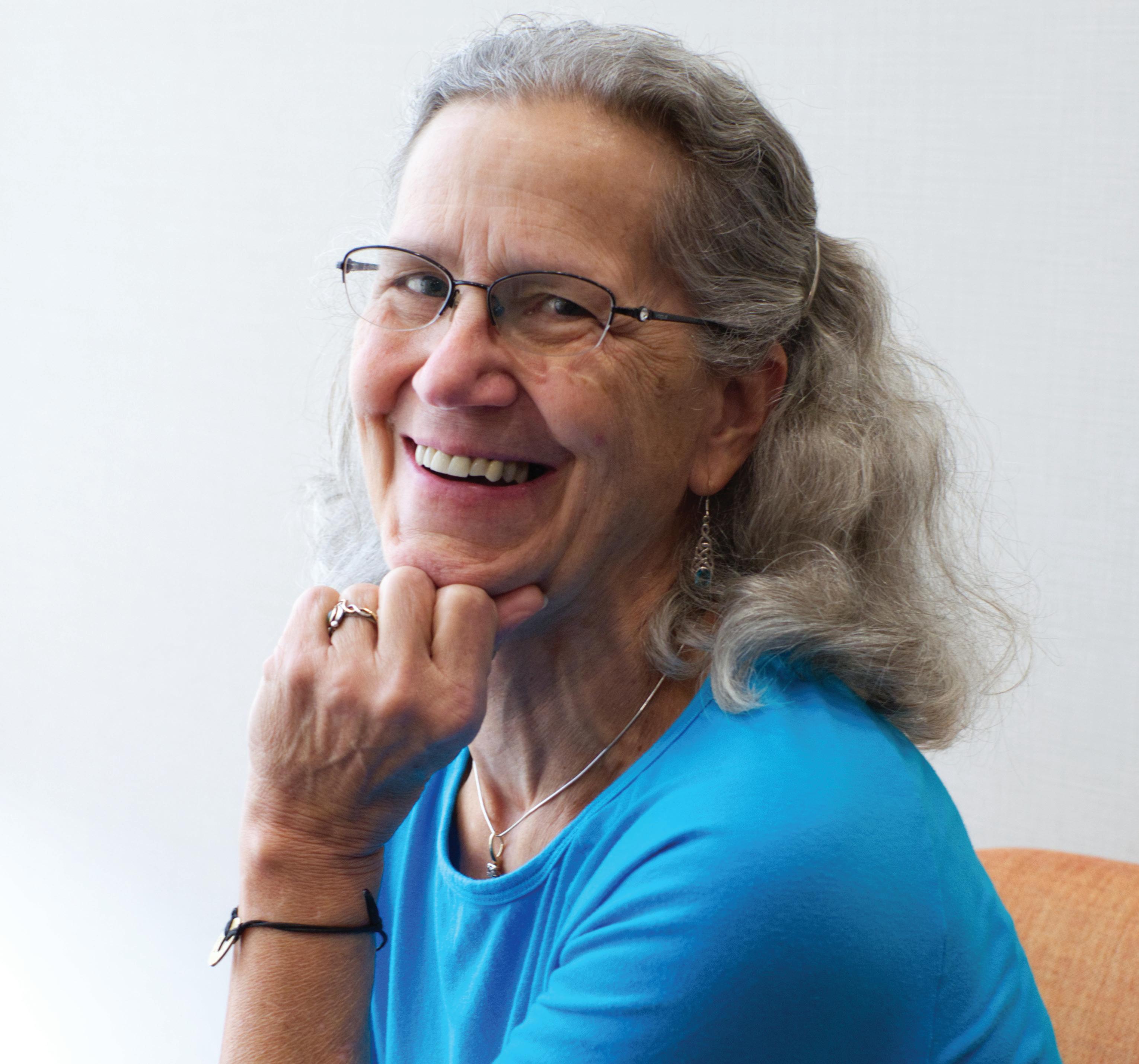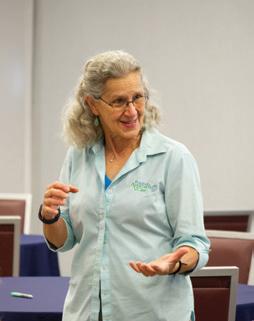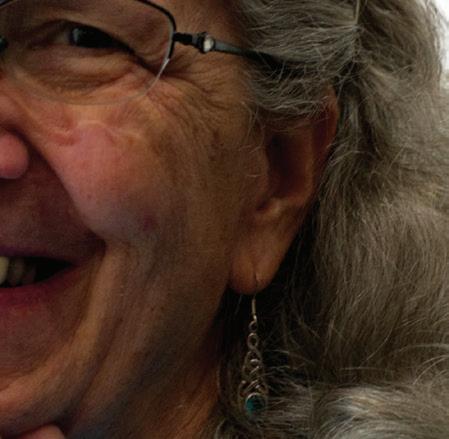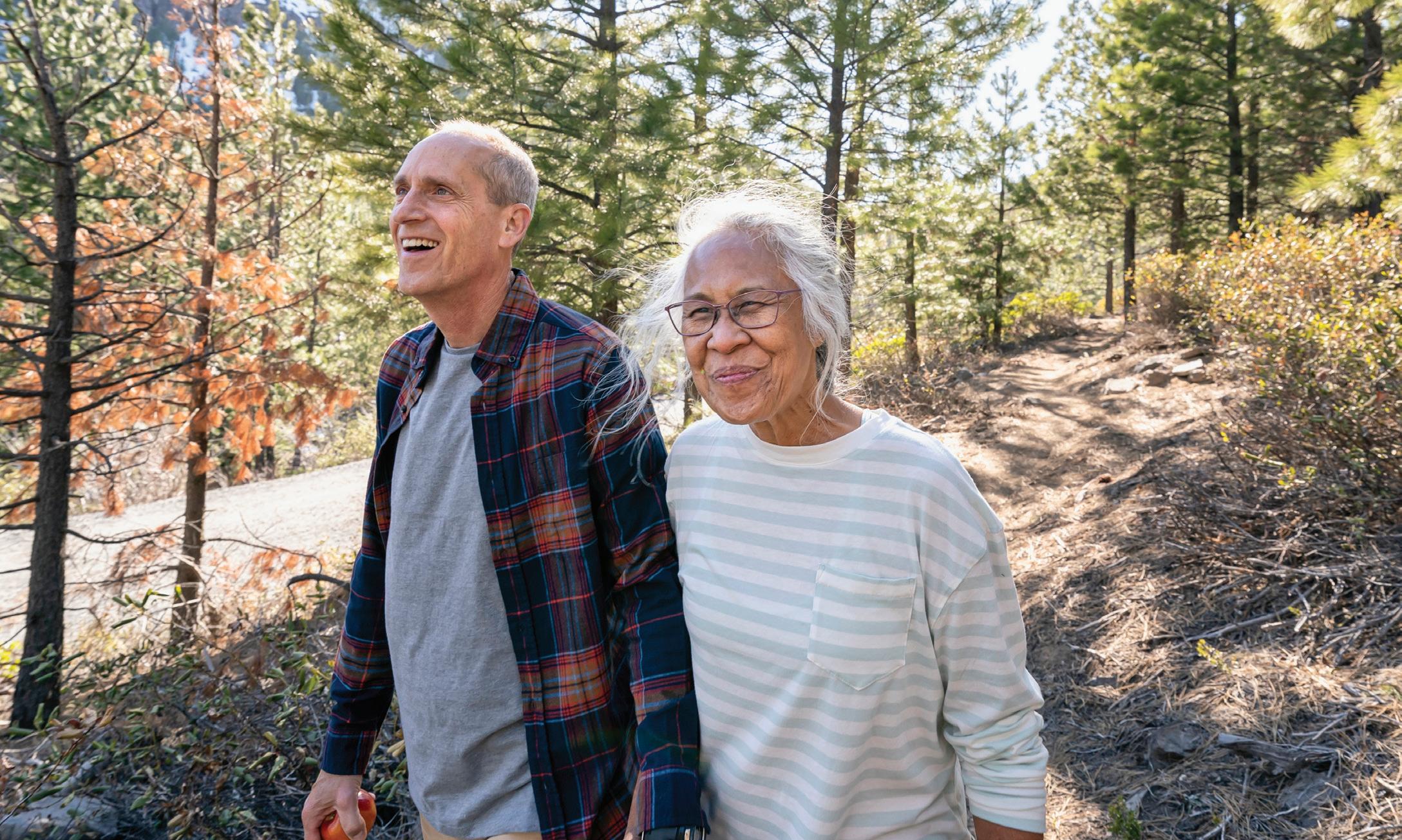Alzheimer’s Awareness

Teepa Snow
The Alzheimer’s advocate shares the importance of creating a more loving dementia care culture




Four important selfcare steps to reduce caregiver burnout 02
How to care for those with AD now while looking toward the future 05


A Mediaplanet
to The
of
Guide
Future
Dementia Care
An Independent Supplement by Mediaplanet to USA Today
FUTUREOFPERSONALHEALTH.COM
DECEMBER 2022 |
Steps To Reduce Caregiver Stress

Caring for a loved one with Alzheimer’s disease or another dementia-related illness is often described as a labor of love. Each year, over 16 million Americans engage in this labor of love, providing more than 17 billion hours of unpaid care for family and friends with dementia.
Frequently, fam ily caregivers prioritize their loved ones’ needs ahead of their own. However, making time for self-care is not selfish; it’s essential to managing stress and avoiding caregiver burnout.
Untreated stress increases the risk of caregiver burnout and numerous other health issues, including high blood pressure, heart problems, anxiety, and depression. Proactive stress management provides shortterm and long-term benefits for caregivers’ physical, mental, and emotional health, which is why it must be a priority. After all, if something happens to the care giver, who will be able to care for their loved one? There are sev eral steps caregivers can take to manage and reduce stress.
Be adaptable and positive Aim for constructive solutions to changing situations. Atti tude and mood have a tremen dous influence. Controlling every stress-causing factor is impossible, but you can control how you react to those stress ors. Focusing on finding solu tions to the problem can help reduce the stress it’s causing. This approach also bene fits the care recipient. If the caregiver is calm and relaxed, it helps the individual living with Alzheimer’s to be as well. Conversely, an angry, agi tated caregiver increases the chances that the person for whom they are caring will be angry and agitated, too.
Take things one day at a time
Resolving everything at once is
both impossible and unrealis tic. Prioritize and set practical goals. Don’t be afraid to get help, even if just means stay ing socially active by talking to family and friends. Be open with them about your feelings. Talking about your stress can help relieve it.
Take care of yourself
This means getting adequate rest, eating a proper diet, drinking plenty of water, and exercising. In addition, do something to clear and refresh your mind, whether it’s doing yoga, meditating, listening to music, walking, or taking a few deep breaths. Find something that works for you and do it regularly.
Connect with support
Every caregiver needs a strong
support system. Relatives, friends, neighbors, profession als, and community-based support services are among the resources available to help. Don’t be reluctant, afraid, or embarrassed to ask for help.
The Alzheimer’s Foun dation of America (AFA) can provide additional informa tion and support. Connect
with a licensed social worker seven days a week through the AFA helpline by calling (866) 232-8484, web chatting at www.alzfdn.org, or texting (646) 586-5283. n
Charles J. Fuschillo, Jr., President and CEO, Alzheimer’s Foundation of America
READ MORE AT FUTUREOFPERSONALHEALTH.COM 2
Be adaptable, positive, and aim for constructive solutions to changing situations. Attitude and mood have a tremendous influence.
@MEDIAPLANETUSA @FUTUREOFPERSONALHEALTH
PLEASE RECYCLE
Publisher Joelle Hernandez Business Developer Joelle Hernandez Managing Director Julia Colavecchia Lead Designer Kayla Mendez Designer Celia Hazard Lead Editor Dustin Brennan Copy Editor Taylor Rice Director of Content and Production Joelle Hernandez Cover Photo Positive Approach to Care ® All photos are credited to Getty Images unless otherwise specified. This section was created by Mediaplanet and did not involve USA Today.
INQUIRIES: US.EDITORIAL@MEDIAPLANET.COM AND US.ADVERTISE@MEDIAPLANET.COM
Eisai Is Pioneering Alzheimer’s Research and Working to Improve the Experience of People Living With the Disease
“Never giving up” is the message Eisai Co., Ltd., emphasizes when it comes to the company’s four decades of Alzheimer’s research.
The global pharmaceutical company headquartered in Tokyo, with its U.S. headquarters in New Jersey, is focused on developing innovative solutions for people and families living with Alzheimer’s disease (AD) and other neurodegenerative diseases.
Driven by its commitment to human health care (hhc) — thinking first about patients and their families — Eisai uses its science, technology, and real-world expertise aims to push past scientific boundaries to deliver life-changing therapies and health-related solutions to patients. They know they have a responsibility to listen to and learn from patients and families.
“Our comprehensive approach to drug develop ment is designed to serve patients with the goal of helping them live healthier and more fulfilling lives,” said Michael Irizarry, M.D., Senior Vice President, Deputy Chief Clinical Officer, Alzheimer’s Disease and Brain Health, Eisai Inc., noting that the company’s personal interactions with patients and caregivers drives its innovation.
Understanding Alzheimer’s disease
Dementia — a term that encompasses a group of dis orders that can affect memory, language, and think ing — can have many causes, but AD is the most com mon form of dementia. AD is a brain disease that’s caused by damage to nerve cells in the brain, called neurons.
It’s the seventh-leading cause of death in the United States and the Alzheimer’s Association says 1
in 3 seniors dies with the degenerative brain disease or another dementia. The association also reports that 55 million people worldwide are living with the disease or another dementia, including 6.5 million Americans 65 and over. This number could more than double by 2060 without development of medical breakthroughs to prevent, slow, or cure the disease.
AD is also a major challenge for families and care givers, as well as healthcare systems and the commu nity at large.
The first symptoms of the progressive disease are problems with memory, language, and thinking. Over time, more brain neurons get damaged and those with the disease may have increased difficulty carry ing out daily activities.
While a family history of AD isn’t necessary for someone to develop the disease, those with a first-de gree relative with AD are more likely to develop it than those without a family history.
The right intervention
Eisai is working to slow the disease progression of AD and other neurodegenerative diseases. The compa ny’s long-term goal is to streamline diagnostics and
research in early disease detection, which can help improve the patient and caregiver experience.
For example, by using blood-based biomarkers, which are measures used to perform a clinical assess ment (e.g., blood pressure, cholesterol level), Eisai can monitor and potentially predict health states in individuals or across populations so appropriate ther apeutic intervention can be planned.

“The biomarkers not only help physicians diagnose
Alzheimer’s disease, but they can allow researchers to refine their recruiting processes for clinical trials,” Dr. Irizarry said. “With these new approaches and diagnostic techniques in place, this may lead to better outcomes.”
Eisai is committed to discovering novel biomarkers to identify the root cause and stage of each person’s disease, and to provide the right intervention, for the right person, at the right time.
“Eisai is at the forefront of research and develop ment for AD, and we continue to tackle the underly ing disease processes,” said Dr. Irizarry. “We are work ing to improve the experience of people living with the disease.” n
Kristen Castillo
Read more about Eisai and its research into Alzheimer’s disease at www.us.eisai.com
SPONSORED MEDIAPLANET 3
Aphasia and the Role of the Caregiver
all aphasia is created equal. With eight different types of aphasia and four subtypes of primary progressive aphasia, caregivers face many challenges
The brain is a complex organ that controls our sensory, motor, and cognitive functions. Sen sory input is processed and responses are formulated via interconnections to differ ent areas of the brain. When these connections are inter rupted suddenly by a blood clot (embolism or aneurysm), bleeding (hemorrhage), or trauma (closed or penetrating injury), brain cells around the damaged area will cease to function, resulting in disorders specific to that area. Gradual changes within brain cells also can occur, resulting in differ ent types of dementia.
Types of aphasia and dementia
Eight different types of aphasia are classified by location, severity of the brain damage, and the functions affected. Anomia resulting in wordfinding problems is the mildest form of aphasia, whereas
global aphasia causes severe difficulties with understanding and expressing speech.
Similarly, the dementias are defined by unique characteris tics of cellular changes. Alzhei mer’s dementia, the most com mon form, results from changes in amyloid and tau in the cells throughout the brain that affect memory and other cognitive functions. In contrast, abnor mal accumulations of proteins in the cell bodies causes Lewy Body dementia and disruptions in social functioning.
There are four subtypes of primary progressive aphasia (PPA). This language disorder can begin with various com binations of comprehension and expressive difficulties, but changes in cognitive abilities appear gradually like different types of dementia. Logopenic and mixed PPA are most often associated with Alzheimer’s pathology, whereas agram matic and semantic PPA are more localized to the frontal and temporal areas.
The challenges of caregiving Caregivers of individuals with these neurological disorders are faced with many chal lenges that require educational and emotional support. When loved ones can no longer express their wants and needs clearly, caregivers need to learn how to support effective com munication.

Speech-language patholo
gists (SLP) conduct evaluations and determine effective com munication strategies that can be shared with caregivers. SLPs may provide information about the disorder and what to expect in the future. However, because the medical commu nity cannot predict the course of any individual’s disease, liv ing with a person with a neu rological condition is challeng ing. Experiences and timelines
often differ among those with the same diagnosis. Caregivers, therefore, are at tremendous risk for stress, depression, and the worsening of their own medical conditions. They often need to be encouraged to develop strong social support networks and to find ways to reduce stress in their lives. n
Michelle Bourgeois, Ph.D., National Aphasia Association
READ MORE AT FUTUREOFPERSONALHEALTH.COM 4
Not
in supporting an individual with these neurological disorders.
She spent 30 years caring for her mother who had Alzheimer’s disease, Par kinson’s disease, and Lewy body disease. In 2009, she founded Alz heimer’s Speaks, a resource for people with the progressive disease and their caregivers.
About AD
AD makes up 60-70% of cases of people with dementia — a condition marked by a deterioration in cognitive func tion, including symptoms like forget fulness, confusion, needing help with personal care, and other symptoms.
Globally, 55 million people have dementia, according to the World Health Organization. In the United States, 6.5 million Americans over 65 have AD. If no treatments or a cure are
found, 13.8 million Americans could have the condition by 2060.
Resources
La Bey wants to share stories of hope and life, and help people with AD know they’re not alone.
She explains that while there’s often a focus on finding a cure, there are people with the disease now who need love and support. It’s important to take care of people with Alzheimer’s now, while also looking to the future.
The Alzheimer’s Speaks website pro vides free resources for people living with AD and their caregivers, includ ing information about radio shows, memory cafes, articles, and informa tion, as well as a link to Dementia Map, a global resource directory of terminol ogy, events, and a blog.
ANITA JADER
Supporting People With Alzheimer’s Disease Transitioning to Different Stages
Advocating for people with Alzheimer’s disease (AD) has been Lori La Bey’s focus and life’s work.

Fighting stigma
La Bey wants people to know the disease is fluid and changes as it pro gresses. She isn’t afraid to fight the stigma of AD and to talk about chal lenging topics like the Alzheimer’s Transition. She says people are being diagnosed early and many live longer, which means those with Alzheimer’s can live with the disease in different stages, from early to middle to late stage.
La Bey is adamant about getting rid of the all-or-nothing idea that a person diagnosed with Alzheimer’s can’t par ticipate in society.
“A person is still a person and it [AD] can’t take away their soul in their heart, their ability to love, and their ability to participate,” she said.
ferent level. For example, people with Alzheimer’s are often able to do a lot during their early disease stage, but they may get pushed to the limits. For example, they may get overwhelmed with tasks, but that doesn’t mean they need to stop. Instead, they need sup port and to have the task broken into manageable steps.
Support
La Bey reminds caregivers not to give up on a person with AD. Instead, encourage them to do the tasks on their own time frame and with sup port.
“Just because they can’t do some thing today doesn’t mean that they can’t do it tomorrow,” she said. n
Still, participation may be at a dif Kristen Castillo
PHOTO:
MEDIAPLANET 5
Why Creating a Positive Care Culture Is Key To Slowing Alzheimer’s

According to the National Conference of State Legislatures, the cost of providing care for those with dementia, including Alzheimer’s, amounted to $271 billion in 2021. The NCSL estimates there are 48 million people who are considered caregivers to adults, and nearly half of those people offer care to someone with dementia.







Teepa Snow is an advocate for those caregivers and the individuals with Alzheimer’s for whom they are caring. Through her initiative, Positive Approach to Care (PAC), she and more than 50 volunteers — some of whom are living with dementia — are working to create a more kind, accepting, and engaging culture around and within Alzheimer’s caregiving.
Battling stigmas
Snow noted that while she has had family members with dementia, what ultimately motivates her in her mission is a desire to spread kindness and respect toward this patient population.



“What drives me is the way people treat individuals who have brain change, as though they were no longer present,”
Snow said. “For me, that’s not the way a human being should be interacted with. It’s potent to watch interactions where a carer is not caring.”

In popular culture, an Alzheimer’s diagnosis is commonly perceived as devastating, and there’s a wide awareness that the disease exists, but these diagnoses can also carry stigma and misconceptions.
“Once someone hears that word — dementia —people will say things like, ‘Well, is she in the violent stage yet?’ It’s like, ‘Well, I don’t know. Have you really ticked her off?’” Snow said. “There’s still so much that’s not okay. I think we have more people who are aware that Alzheimer’s is out there, but I think there’s still such huge misunderstanding, and we have a long way to go.”
Caregiver self-care
For those who have just started caring for someone with Alzheimer’s, Snow recommends taking a curious, not judgmental, approach to the patient’s behavioral changes.
“As your individual is changing, recognize there are things they’ll start to do because they can’t do the other thing,” Snow advised.
Always seek out the things you still love about the person you’re caring for, and if you can’t identify one of those things, it’s a clear sign you’re burned out, Snow explained. If that’s the case, find, build, and lean on your support system.
“Not liking someone makes the job even harder, and it will exhaust you because you don’t have any moments of pleasure in your day. So, we’ve got to get you recharged,” Snow said. “This is a 24/7 job and nobody can do it 24/7.”
Hope for the future
Snow has hope for creating a more loving dementia care culture, as well as for advance-
ments in Alzheimer’s treatment and management itself.
She referenced the growing use of technology for social engagement and exercise such as dancing, as well as the emergence of complementary health approaches like animal, music, and cooking therapy. The goal of these therapies, she noted, is to reduce the amount of damage to the brain for as long as possible, until there is potentially a cure for Alzheimer’s disease one day.
Regardless, human connection is invaluable, Snow noted.
Although some researchers are experimenting with putting the so-called love hormone, oxytocin, in a pill to help slow
cognitive loss (a recent study suggested potential promise for the method in mice), no pill will ever be a replacement for real-life human engagement, she argued.
Snow sees proof of that notion in the people she works with. When caregivers stop to engage with their loved ones and use the approaches she and her colleagues suggest through PAC, they often have a-ha moments that, for Snow, make the job worthwhile.
“When people come back and say, ‘Oh, I tried it and it worked,’ for me, that’s the icing on the cake,” she said. n
Melinda Carter
READ MORE AT FUTREOFPERSONALHEALTH.COM 6
There’s a reason why care for people with progressive neurodegenerative diseases costs so much — being a caregiver is hard work.
PHOTO: POSITIVE APPROACH TO CARE®
5 Ways to Lower Your Risk for Alzheimer’s Disease

The American Brain Foundation funds research across all brain diseases with the understanding that if we cure one disease, we will cure many. This includes diseases like Alzheimer’s, which affects more than 6 million Americans.
Alzheimer’s causes brain changes that affect memory, thinking, and the ability to complete daily tasks, and cur rently there is no cure. How ever, there are steps you can take to reduce your risk:
1 Protect your heart
Four major risk factors directly relate to heart health: high blood pressure, obesity, diabetes, and smoking. You can
reduce your risk by using med ication and making lifestyle changes to lower blood pressure and cholesterol, eating health ily to manage your weight, and working with a doctor to man age your blood sugar. You can also talk to your doctor about how to quit smoking.
2 Get moving
According to Richard Isaacson, M.D., FAAN, exer cise can be the brain’s first defense against amyloid
plaque, which builds up in the brains of people who have Alz heimer’s. Aim for 30 minutes of daily activity.
3
Stay socially and mentally active
Get together regularly with family and friends. Meet new people, and work or volun teer with community groups. Read or do puzzles daily and build vital backup pathways in the brain by learning a skill, such as a new language.
4 Avoid head injury
Head trauma, whether severe or mild, increases dementia risk. Wear a seatbelt, play sports safely, and treat any head injury immediately.
5
Treat depression, hearing loss, and substance abuse
Excessive alcohol consump tion, hearing loss, and depres sion increase the risk for dementia. You can greatly lower your risk by drinking
in moderation and wearing hearing aids. Additionally, it’s critical to reach out to friends, family members, a doctor, or the National Suicide Preven tion Lifeline (800-273-8255) if you experience symptoms of depression, such as frequent or extreme sadness, self-iso lating tendencies, or thoughts of self-harm. n
MEDIAPLANET 7
American Brain Foundation and Brain & Life ®
Read more about alzheimer’s awareness at futureofpersonalhealth.com



























